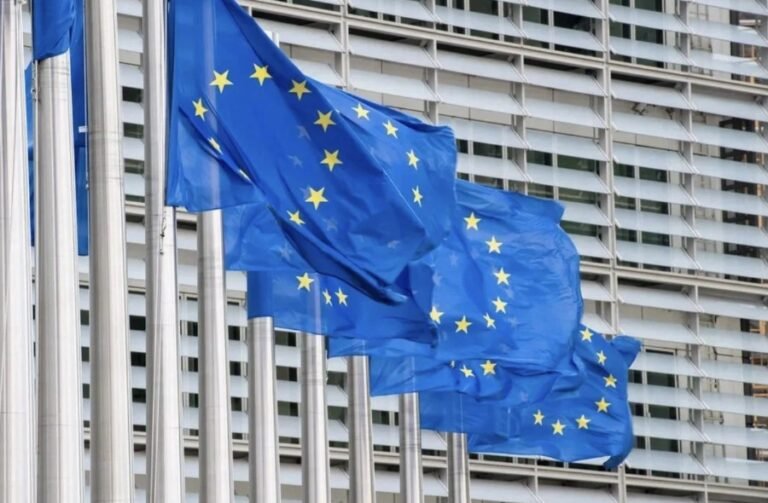The European parliamentarians have called on the EU to impose “more targeted” sanctions against Russia’s so-called ‘shadow fleet’.
Russia uses old tankers, often uninsured and with unclear ownership, to export its crude oil and petroleum products abroad, despite EU, G7 and international sanctions. These activities have also raised fears over the risk of environmental disasters, including severe oil spills.
As part of systematic efforts to undermine EU restrictive measures, the ‘shadow fleet’ is said to provide a key financial lifeline for Russia in its war with Ukraine.
In a resolution adopted on November 14, 2024, the European Parliament called for more targeted measures against these vessels in the next EU sanctions packages, including all individual ships as well as their owners, operators, managers, accounts, banks and insurance companies.
The parliament also demands “the systematic sanctioning” of vessels sailing through EU waters without known insurance and urges the EU to enhance its surveillance capabilities, especially drone and satellite monitoring, and to conduct targeted inspections at sea.
Specifically, Members of the European Parliament (MEPs) want EU member states to designate ports capable of handling sanctioned vessels carrying crude oil and liquified natural gas (LNG) and to seize illegal cargo without compensation.
The resolution further calls on G7 countries to better enforce the price cap imposed on Russian seaborne oil, to substantially decrease the oil price cap and to crack down on the loopholes used by Russia to repackage and sell its oil and oil products at market prices.
The terms ‘shadow fleet’, ‘dark fleet’ and ‘grey fleet’ have come under the spotlight since the West imposed sanctions on Russia’s energy exports and Russia began its attempts to circumvent them.
In December 2023, the International Maritime Organization (IMO) agreed for the first time on a precise definition of the term: “[the IMO Assembly] decides that for the purpose of this resolution, ‘dark fleet’ or ‘shadow fleet’ mean ships that are engaged in illegal operations for the purposes of circumventing sanctions, evading compliance with safety or environmental regulations, avoiding insurance costs or engaging in other illegal activities (…).”
The use of ‘shadow fleets’ or ‘dark fleets’ is not a new phenomenon – countries such as Iran, North Korea, Venezuela and Russia (even before its full-scale invasion of Ukraine) have resorted to it regularly in the past. However, since the imposition of international sanctions in response to its invasion of Ukraine, Russia has taken the use of the ‘shadow fleet’ to another level, both in numbers and in the sophistication of mechanisms adopted, according to the European Parliament.
Since March 2022, Russia has made ‘extensive efforts’ to circumvent the international sanctions and, in particular, the oil price cap. The Kyiv Scool of Economics (KSE) report estimates that Russia has invested $10 billion in developing its shadow fleet, in order to continue trading Russian oil at market prices by avoiding G7/EU vessels, ports and financial and maritime services.
The Russian government has focused in particular on:
• shifting tankers previously owned by Russian entities to new management companies;
• buying vessels over 15 years old from the cleared fleet that previously held P&I insurance from the International Group (IG); and
• acquiring very old vessels (20+ years) from both shadow and cleared fleets.
Many shadow fleet vessels use flags of convenience from countries that are either less inclined or unable to enforce Western sanctions. The top countries whose flags are used by shadow tankers transporting Russian crude oil include the Cook Islands, Eswatini, Gabon, Liberia, Malta, Marshall Islands, Panama, and Russia itself. According to Windward investigation, 12% of dark fleet vessels and 10% of grey fleet vessels are sailing under EU Member States’ flags. By flying these flags, ships can appear to be independent of Russia, making it challenging for regulatory bodies to trace the cargo back to Russian oil sources. In addition, Russia used the tactic of the frequent reflagging of vessels.
The old and often uninsured or poorly insured tankers are believed to transport over 70% of Russia’s crude oil exports. There are fears that, while avoiding oil sanctions, these en-of-life ships might cause an environmental catastrophe near or within the EU waters.
According to MEP Sandra Kalniete, EPP group, these vessels are “ecological time bombs that threaten the world’s waters with oil spills.” According to Kalniete, who recently spoke in a European Parliament debate, not enough shadow fleet tankers are being sanctioned by the EU.
Russia’s shadow fleet is growing, and despite the efforts to quantify it, the exact number of ‘shadow’ vessels and tankers remains unknown. The estimated number differs significantly between different sources. For instance, S&P Global estimates that approximately 591 shadow fleet tankers are operating in the Russian oil trade, 271 of which operating as ‘dark fleet’.
• Gibson: Russia targeting year-round sailing in Northern Sea Route as early as 2025
• EU’s ties to Russian gas: LNG tanker routes pinpoint ports in four European countries as touchpoints
• UK activists stop Russian oil tanker from docking, calling on govt to ‘stop funding Putin’s war in Ukraine’
• Activists block Russian oil tanker in Norwegian port, calling on govt to ‘stop fueling the war’
• Denmark challenges Greenpeace to a fight in court over protests hindering transit of Russian oil
